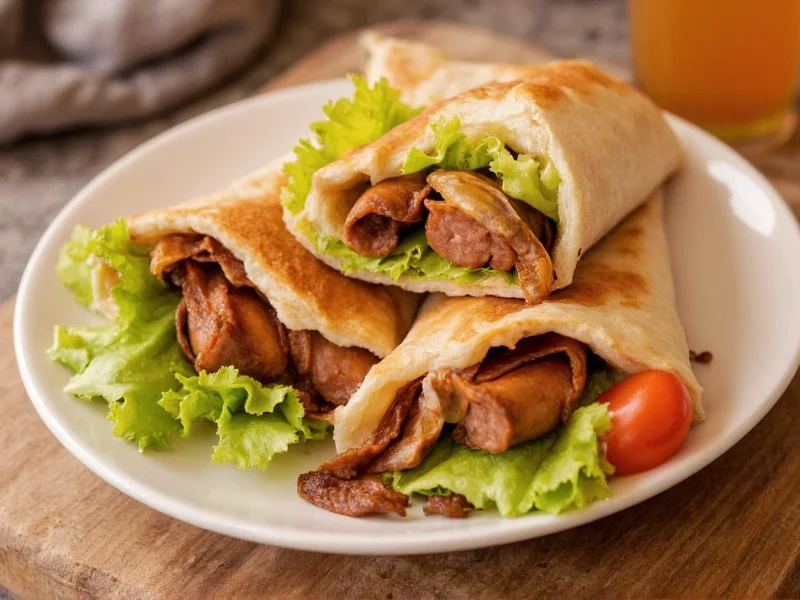The Essential Components of a Perfect Sausage Wrap
Creating an exceptional sausage wrap requires understanding its fundamental elements. The sausage itself serves as the protein foundation, while the wrap provides structure and complementary flavor. Supporting ingredients enhance texture and taste complexity without overwhelming the main components. When selecting ingredients for how to make sausage wraps at home, prioritize quality over quantity—three to four well-chosen elements typically create a more satisfying experience than overloaded combinations.
Selecting the Right Sausage
The sausage variety dramatically impacts your wrap's character. For breakfast sausage wraps, choose mild or maple-flavored pork sausage that pairs well with eggs and cheese. Dinner applications often benefit from Italian sausage with fennel and garlic notes, or bratwurst for a heartier profile. When preparing healthy sausage wrap options, consider turkey or chicken sausage alternatives with reduced fat content. Always cook sausage thoroughly before wrapping—undercooked sausage presents food safety risks while overcooked sausage becomes dry and crumbly.
Wrap Selection Guide
The foundation of any successful sausage wrap recipe depends on appropriate bread selection. Different wrap types serve distinct purposes:
| Wrap Type | Best For | Heating Tip |
|---|---|---|
| Flour Tortilla (8-10") | Most sausage varieties | 30 seconds in dry skillet |
| Spinach Wraps | Lighter breakfast sausage wraps | Room temperature folding |
| Naan Bread | Spicy sausage varieties | Light toasting |
| Corn Tortillas | Mexican-inspired sausage wraps | Double layer for strength |
Step-by-Step Sausage Wrap Preparation
Follow these steps for restaurant-quality sausage wraps at home. First, cook sausage thoroughly in a non-stick skillet over medium heat, breaking into appropriate pieces for your recipe. While sausage cooks, prepare complementary ingredients—sautéed peppers and onions work well for dinner wraps, while scrambled eggs complement breakfast versions. Warm your chosen wrap according to the table above. Arrange ingredients strategically: place sausage slightly off-center, add supporting elements, then fold bottom flap up and sides inward to create a secure package. For easy sausage wrap assembly, avoid overfilling—most 8-10" wraps accommodate 3-4 ounces of cooked sausage plus accompaniments.
Popular Sausage Wrap Variations
Regional and meal-specific adaptations have made sausage wraps a versatile culinary staple. The Chicago-style Italian sausage wrap features grilled Italian sausage, sweet peppers, onions, and giardiniera on a poppy seed bun. Breakfast enthusiasts enjoy the classic egg and sausage wrap with cheddar cheese and optional hash browns. Health-conscious cooks create nutritious sausage wraps using turkey sausage, whole wheat tortillas, and vegetable fillings. For vegetarian adaptations, consider using plant-based sausage alternatives with roasted vegetables and hummus spread.
Common Mistakes to Avoid
Many home cooks encounter issues when preparing sausage wraps for the first time. Excessive moisture from uncooked vegetables causes wraps to tear—always sauté watery ingredients like tomatoes or zucchini before adding. Using cold wraps straight from refrigeration makes folding difficult; allow 30 seconds for warming. Overfilling remains the most frequent error in easy sausage wrap recipes—limit fillings to prevent structural failure. Finally, wrapping too early after cooking sausage traps steam that softens the wrap excessively; let sausage rest for 2-3 minutes before assembly.
Serving and Storage Recommendations
Serve sausage wraps immediately for optimal texture, as prolonged sitting causes wraps to soften from ingredient moisture. For meal prep, wrap tightly in parchment paper then foil—this technique preserves structure better than plastic wrap. Properly stored sausage wraps maintain quality for 3-4 days in refrigeration. When reheating, use an oven or air fryer rather than microwave to preserve wrap integrity. For frozen sausage wraps, thaw overnight in refrigerator before reheating to prevent sogginess.
Frequently Asked Questions
What's the best way to prevent sausage wraps from getting soggy?
Prevent sogginess by thoroughly cooking moist ingredients like tomatoes or peppers before assembly, allowing cooked sausage to rest for 2-3 minutes before wrapping, and using a thin layer of spreadable cheese or hummus as a moisture barrier between the wrap and fillings.
Can I make sausage wraps ahead of time for meal prep?
Yes, sausage wraps work well for meal prep when properly wrapped. Cool completely after assembly, then wrap tightly in parchment paper followed by aluminum foil. Store in refrigerator for up to 4 days. Reheat in oven or air fryer at 350°F for 8-10 minutes rather than microwaving to maintain texture.
What are good vegetarian alternatives for sausage in wraps?
Excellent vegetarian alternatives include plant-based sausage crumbles, seasoned lentils, grilled portobello mushrooms, or spiced chickpeas. Pair these with complementary ingredients like roasted vegetables, avocado, and flavorful spreads to maintain the satisfying texture and taste profile of traditional sausage wraps.
How do I keep sausage wraps from unraveling during eating?
Prevent unraveling by using the proper folding technique: place ingredients slightly below center, fold bottom flap up about 1 inch, then fold sides inward before rolling forward. Don't overfill—3-4 ounces of cooked sausage plus accompaniments works best for standard 8-10" wraps. For portable options, secure with parchment paper wrapping.
What sides pair well with sausage wraps for a complete meal?
Ideal side dishes include simple green salads, roasted vegetables, sweet potato fries, or fresh fruit. For breakfast sausage wraps, pair with fresh orange juice or coffee. Dinner versions complement well with crisp slaws or light vegetable soups. The key is choosing sides that don't compete with the wrap's flavors while providing textural contrast.











 浙公网安备
33010002000092号
浙公网安备
33010002000092号 浙B2-20120091-4
浙B2-20120091-4